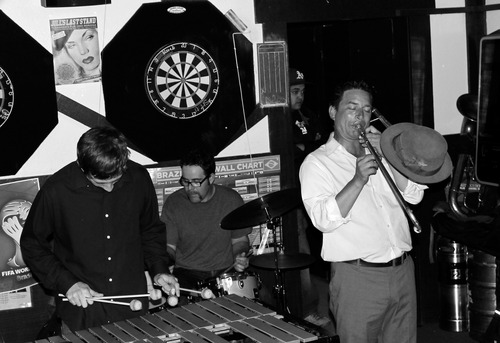
To celebrate this month’s music issue, we’re posting a piece written by Joseph Bien-Kahn on San Francisco Jazz trombonist, Danny Grewen.
Even dressed up, Danny Grewen is a little disheveled—in a pinstriped suit, a polyester button-down with the collar open, and a fedora he’s still all herks and jerks. Grewen is lugging around a taped-up trombone and a messenger bag open and overflowing with tape recorders, loose wires, and microphones when I interview him. He has a head of curly black hair and boyish good looks that clearly serve him well. But the thing that strikes you most about Grewen are his hands—they are strong and calloused and cracked; the hands of a blue-collared worker. The stereotype of the coddled artist continues to persist, but in today’s San Francisco, if you want to play jazz and pay rent, you have to work.
I met Grewen at Trouble Coffee in the Outer Sunset. Every once in a while he’d say something too sharp and a little too dark when talking about the city, and then burst out into untended laughter. He talks the way he moves, quick spurts with long breaths, a mischievous grin peeking out of his stubbly jaw. He kept his bag over his shoulder and recorded the interview on an ancient tape recorder he’d found at the corner of 45th and Kirkham for his own records. Grewen’s well loved in the neighborhood—at the coffee shop and later at the Flanahan’s Pub a few blocks down, everybody knew his name. But because of a jump in rent, he’ll soon be forced to move.
It hardly needs restating that San Francisco’s rents are rising at an alarming rate. According to a November 2013 article in the New York Times, the median rent for a two-bedroom apartment is a staggering $3,250, the highest price in the nation. Only 14 percent of homes are accessible to middle-class buyers.
The city is changing which is what cities do. But it means it’s becoming harder and harder to be a musician in San Francisco, especially a jazz trombonist. It’s nearly impossible for Grewen—who grew up in the Richmond, San Francisco’s sleepy northwestern district by the beach, with his mom (also a musician), and attended the School of the Arts—to stay. Now he’s crashing on couches, looking for something affordable in the most expensive renters’ market in the nation.
He left the city once, briefly, to play jazz on cruise ships—“Well, that’s not really jazz is it?”—but has spent the last fifteen years gigging around San Francisco. It’s been a long time since music was lucrative here, but Grewen has made a fine living playing jazz trombone. But now, at...
You have reached your article limit
Sign up for a digital subscription and continue reading all new issues, plus our entire archives, for just $1.50/month.
Already a subscriber? Sign in




